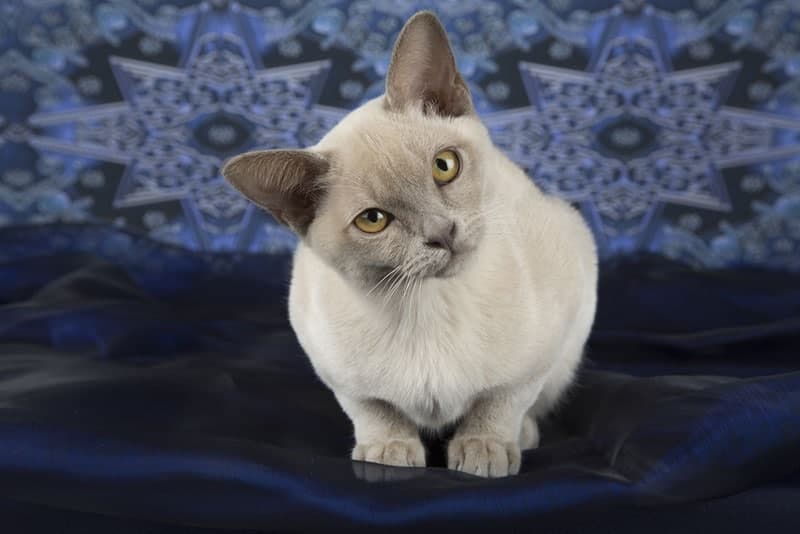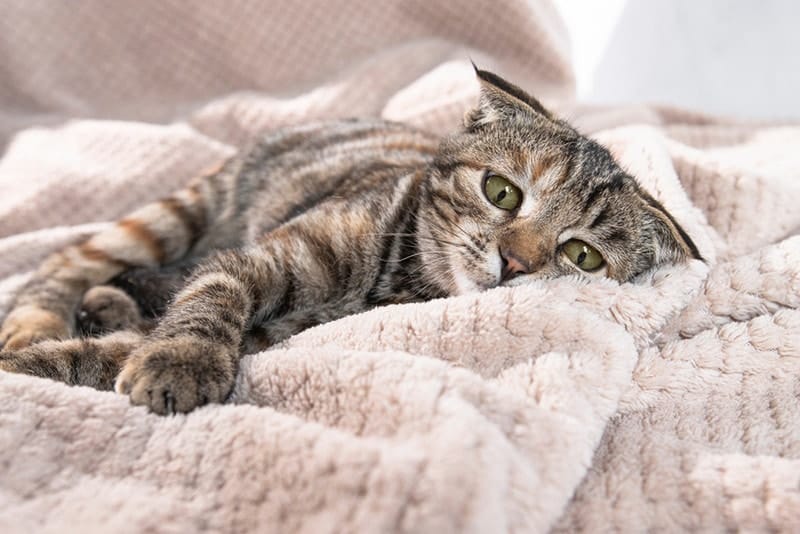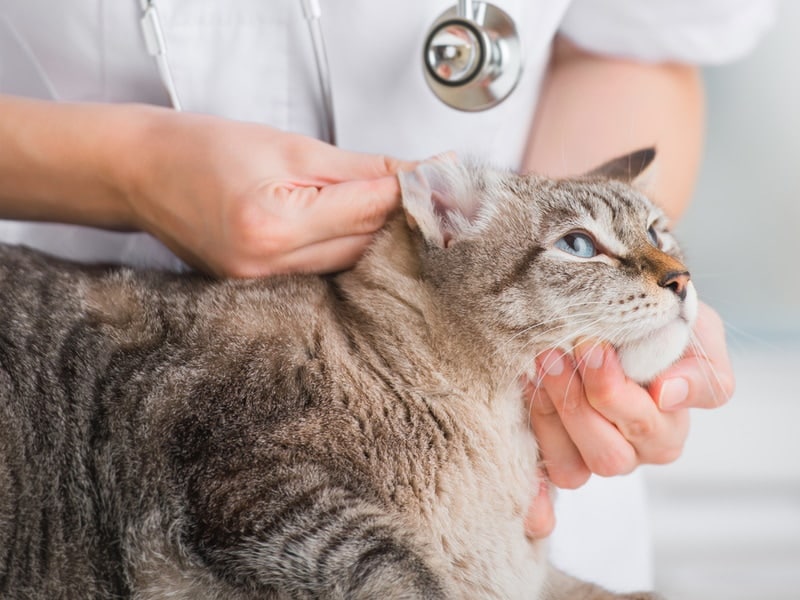It may be fairly alarming to out of the blue see the one you love cat exhibit a tilted head, eyes darting backwards and forwards wildly (nystagmus), and falling with out having the ability to get again up. If these sudden and extreme indicators come into play, it’s very seemingly that the cat’s vestibular system, which helps regulate stability and coordination, is affected.
Learn on to search out out extra about vestibular illness in cats and the causes, indicators, and coverings for this medical situation.
Click on Beneath to Bounce Forward:

What Is Vestibular Illness?
A wholesome vestibular system usually permits for coordination of the physique’s stability, place, and motion in time and area. The epicenter of the vestibular system is situated within the center and internal ear and sends alerts to the eighth cranial nerve (referred to as the vestibulocochlear nerve) that then meet within the medulla, the place the mind and spinal wire join.
When there are issues with the vestibular system, the nervous system is affected, and it sometimes comes about very out of the blue. There are two essential kinds of vestibular illness—central and/or peripheral. It’s extra widespread to have peripheral vestibular issues than central. The central vestibular system points are sometimes related to lesions which can be within the brainstem or cerebellum (space of the mind in the back of the cranium) whereas peripheral vestibular system issues are related to lesions which can be within the internal ear and eighth cranial nerve (vestibulocochlear nerve).
Though vestibular illness in cats will not be unparalleled, it’s additionally not extraordinarily widespread. In cats, a sort of peripheral vestibular illness referred to as feline idiopathic vestibular illness is likely one of the commonest vestibular illnesses recognized in cats. As a result of it’s idiopathic, by definition, it means the trigger is unknown at the moment.

What Are the Indicators of Vestibular Illness?
Indicators that may happen in each or both peripheral and central vestibular illness, embrace:
- Head tilt
- Circling, falling, rolling
- Nystagmus
- Ataxia (uncoordinated strolling)
- Vomiting, nausea, and extra salivation as a result of “movement illness”
There are numerous indicators that may happen in simply central vestibular illness instances and a few that happen simply in peripheral vestibular illness instances. For instance, for central instances, you may even see weak spot and despair or adjustments in posture, whereas peripheral instances might have facial drooping from Horner’s syndrome or a scarcity of indicators seen with central illness.
What Are the Causes of Vestibular Illness?
Central vestibular illness might be brought on by some or any of the next:
- Infectious and inflammatory causes akin to feline infectious peritonitis (FIP), bacterial, fungal, protozoal, and many others.
- Trauma
- Tumor/most cancers
- Thiamine deficiency
- Metronidazole (an antibacterial and antiprotozoal remedy) toxicity
- Vascular occasion
- Brainstem abscess
Peripheral vestibular illness might be brought on by some or any of the next:
- Center or internal ear infections
- Feline idiopathic vestibular illness (unknown trigger)
- Nasopharyngeal polyps
- Toxicity akin to from aminoglycoside (a sort of antibiotic) or lead
- Tumor/most cancers
- Trauma akin to a fracture of the tympanic bulla (a hole bone construction that homes the center and internal ear) or as a result of ear flushing

How Do I Look after a Cat with Vestibular Illness?
If you’re seeing vestibular indicators, akin to these talked about above, you’ll seemingly need to make an appointment together with your cat’s veterinarian. On the veterinary hospital, a cat would profit from receiving a full bodily examination in addition to detailed neurologic and otoscopic (ear) exams. The knowledge from this stuff mixed typically may also help veterinarians have a beginning place if the vestibular illness is central or peripheral. From there, they’ll attempt to pinpoint or rule out the trigger and typically additional testing could also be indicated, which may vary from bloodwork and ear testing to an MRI or spinal fluid faucet evaluation for tougher, extreme, or long-term sicknesses.
As a result of there’s not a singular trigger for vestibular illness, there’s not one therapy that matches all. For vestibular illness, both central or peripheral, the therapy can be decided by the particular illness inflicting the problem. In actual fact, in idiopathic instances the place there isn’t a recognized trigger, the therapy is commonly persistence and time, as these instances might resolve on their very own spontaneously. If there’s a remedy toxicity the remedy will have to be stopped. For center or internal ear infections, there are sometimes antibiotics, steroids, and different therapies to assist resolve the problems.
Many instances, supportive nursing care will have to be carried out to assist these cats who really feel topsy-turvy! A cat’s veterinarian might prescribe a particular remedy for nausea and vomiting whereas a cat is therapeutic. Typically, extra severely unwell cats may want meals and/or liquid assist which might embrace subcutaneous or intravenous fluids in addition to urge for food stimulant medicines and even feeding tubes if wanted.


Regularly Requested Questions (FAQs)
What’s the general prognosis for my cat?
The general prognosis for an affected cat will depend upon the particular reason for the vestibular illness. For instance, feline idiopathic vestibular syndrome has an awesome prognosis and will resolve by itself inside just a few days to weeks. Nonetheless vestibular illness as a result of a tumor might have a extra guarded prognosis. Typically talking, peripheral vestibular illnesses are inclined to have an total higher prognosis than central ones.
What can I do to assist my cat really feel extra snug at residence till they enhance?
At residence, having a quiet, calm surroundings with out brilliant lights may be useful. It might be finest to quickly preserve a cat in a room that has all of their wants in a small quantity of area so that they don’t need to journey far to get to what they want. Protecting them away from stairs or the power to leap up on excessive locations can even assist. As well as, a cat might even want help being put into the litter field infrequently or positioned by their meals and water whereas they’re therapeutic. As a result of cats naturally love to cover, maybe a field with thick padding or a cat mattress could also be comforting to them as they get better.

Conclusion
Vestibular illness in cats might be an alarming factor for each your cat to endure in addition to so that you can witness. The particular reason for the indicators will decide the following step, however with a while and a few medical intervention, many of those instances can get better. In case you discover any indicators of vestibular illness in your feline buddy, your cat’s veterinarian is simply a cellphone name away.
Featured Picture Credit score: David Herraez Calzada, Shutterstock



